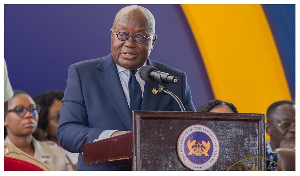Rather uncharacteristic of the secretive organisation, the Ghana National Petroleum Corporation (GNPC) finally issued a press statement to respond to concerns raised by civil society about Ghana’s underperforming oil industry.
While the GNPC is to be commended for its increasing responsiveness and transparency, its grudging tone detracted somewhat from its attempt at responding to its critics and stakeholders.
The notion that all civil society organisations (CSOs) should submit themselves to a GNPC-preferred process when raising legitimate issues of public interest struck us as rather old-fashioned. In the age of social media, the general public is the appropriate audience for such discussions of national interest.
GNPC as a public enterprise has a public-funded public affairs unit with a duty to be proactive in engaging civil society organisations and others who take a keen interest in their work. It is not these voluntary bodies and groups of private citizens that must “reach out” to the GNPC. It is the GNPC that must reach out to the public, and to the extent that CSOs may be able to assist in that effort it is the GNPC that must proactively provide such CSOs with data and information.
IMANI’s mandate is to engage in a fearless mediation between critical technical agencies and the lay public whether such agencies appreciate our effort or not. We seek to ensure that technocrats and bureaucrats do not hide behind jargon to evade democratic accountability. If that means that our choice of language shall be described as “unscientific” by the likes of the GNPC, so be it. The truth is that the information the GNPC has now supplied to inform the public debate about Ghana’s oil sector would not have received broad coverage had IMANI not engaged in strong advocacy to demand such information.
Now, to the substance of the GNPC’s statement.
Despite repeated use of such unflattering adjectives as “uninformed”, “unscientific”, “wrong” etc., the GNPC’s statement failed to settle any of the critical questions raised by IMANI, and in various aspects appeared calculated to perplex rather than to enlighten. We will illustrate our meaning using the same headings and some of the sub-headings favoured by the GNPC.
* *
**JUBILEE PRODUCTION PROSPECTS**
* *
The GNPC was fulsome in praise about the record of Jubilee’s development. As far as they are concerned, the operational and safety performance has been remarkable. Such uncritical adulation masks the fact that the original Jubilee plan of development was considerably scaled down in order to “fasttrack” the path to first oil.
We have studied the documents presented in the original road-shows conducted in Europe, prior to the onset of development work, and it is clear that the final roll-out was scaled down to less than 50% of the original blueprint. This has exaggerated the success rate of activities whilst undermining project resilience.
It is trite knowledge that the number of production/development wells is a major determinant of total oil outflow, especially in a new field. The decision to drastically reduce the number of production wells in Phase 1, likely because of abnormally high unit well costs, has led directly to the loss of productivity occasioned by the technical challenges that took some of the wells from action. Put another way, redundancy planning was poor. It is clear that the fasttrack strategy was technically over-optimistic and strategically risky. It makes sense therefore to question how lessons learnt are being incorporated into the current expansion phase (1a). The monies being spent are monies that ultimately will be deducted from what is due Ghana, so it is important we know.
The GNPC conveniently stayed away from addressing the issues that have led to the Jubilee field performing at HALF its projected capacity. It is not that projections cannot be missed. The problem is the EXTENT of deviation from set targets. Such a stupendous failure to meet projections cannot be described in the adulatory tones the GNPC appears to prefer.
We have asked the GNPC to explain clearly why remedial work, attributed solely to sand contamination, has led to such a significant drop in productivity (i.e. such a high proportion of wells shut down or declining in output), when there is evidence that in similar scenarios elsewhere remedial work has led to NO drop in productivity. IMANI has carefully reviewed industry literature on sand contamination-related remedial work in sections of the Centrica-operated Chestnut oilfield in the North Sea, among others, to confirm that loss of productivity is not a *standard* feature of flowline contamination by formation sand. Why is the Jubilee case so pernicious? The GNPC refuses to even discuss the matter. Its default style continues to be low transparency.
GNPC quibbles with IMANI’s concerns about continuing over-optimism with respect to ongoing remedial work and yet, in the end, agrees with IMANI’s view that medium-term output in the wake of Phase 1a first oil coupled with successful remedial work shall hover below 80,000 barrels. As is its style the GNPC refuses to acknowledge the possibility of potential output regression and continues to promote the 120,000 barrel per day medium-term output trajectory despite several postponements of this sacred milestone. The truth is that similar promises have been made before. The real question is why various “ramp up” scenarios and milestones announced by the same GNPC-led joint management team have been missed at least 4 times already. That is what Ghanaians want better explained.
Where IMANI mentions “new floors” of below 60,000 barrels per day of production, GNPC refuses to discuss the alarming development, and seeks instead to portray IMANI as incapable of differentiating between yearly averages and production troughs. This is strawman argumentation unbecoming of such a major parastatal.
* *
**JUBILEE FIELD DEVELOPMENT COSTS**
* *
GNPC sought to attribute what we maintain are abnormally high costs in Jubilee to normal seasonal variation due to the price of oil. In this comfortable theory of the national oil company rig rates correspond solely to crude oil prices.
We are surprised that a national oil company will adopt so credulously a theory that in the professional literature is heavily qualified.
Work by experts such as N. M. Rach and others has always emphasised a multitude of factors in the determination of rig rates, including the pace of construction of new rigs (to take advantage of rising day rates), skilled labour availability (the average rig technician can easily earn more than $100,000 a year due to labour supply issues), and capital costs. How an official press release from the GNPC of all organisations can reduce this affair to oil prices alone beats our imagination. We also note, with sadness, that the GNPC does not even bother to explain that in every empirical examination of the correlation of oil price movements and rig day rates, a lag of up to 12 months has been observed WHEREVER a positive dependence has been observed. There is therefore NO simple, simultaneous and co-linear link between dayrates and the spot price of oil.
With this in mind, we can continue to examine the other points made by the GNPC.
It is baffling that an organisation required to make public disclosures of activities in the oil sector chose to resort to general statistics in order to clarify matters of public financial interest.
Why didn’t the GNPC simply list the semi-submersible and floating rigs that have been contracted to work in Jubilee since the onset of development along with their dayrates? Is the GNPC interested in financial disclosure or merely in argument for argument sake?
They clearly shied away from this because once again another flawed theory of theirs would have fallen flat on its face. In seeking to justify abnormal rig rates for Jubilee, the national oil company decided to use the geographical location of Jubilee as the cost driver. How Ghana which is located much closer to major rig markets such as the North Sea, and which is next door to Nigeria, a country with massive deepshore prospects, can be more geographically disadvantaged than Angola beats our mind.
The truth that the GNPC did not want to confront is that the rig market, like all markets, works through quotes and negotiations. It is up to operators to devise the optimal mix of factors while contracting to take advantage of pricing variability and volatility. If the cost drivers were in the form preferred by the GNPC, Atwood would not have rented out its Osprey to operators in faraway Australia for 10% less than it did to Ghanaian operators, when the Osprey has nearly TWICE the performance specs of the Hunter being used in Ghana. In fact, the same Atwood would not have rented out its Falcon, a vessel of the same generation 3 specs as the Hunter, to operators in Australia for nearly 50% less.
It is shocking that Ghanaian operators, under the GNPC’s leadership, are reporting operating day rates for generation 3 semi-submersibles higher than generation 6 and 7 machines. At these reporting day rates, and with the acquisition costs of generation 5 semi-submersible rigs made by shipyards like Hyundai going for less than $600 million (before capital costs), it would have made strategic sense for Ghana to acquire its own 3rdgeneration fleet, outsourced management, and then leased the vessels to the operators to cash in on this booming trade! We say this tongue in cheek but the $1.6 million, pre-completion, daily drilling rate quoted by the GNPC clearly deserves such a reaction.
Indeed, we note with great apprehension the lack of compunction with which the GNPC wants Ghanaians to accept that spread rates of FOUR TIMES the rig rates should be considered NORMAL (i.e.the cost of hiring the rig as a proportion of total logistics costs). There is nothing more ABNORMAL than this.
Extensive examination of cost profiles around the world, including in nascent offshore industries, has established a firm general correlation between rig rates and spread rates. Very *rarely* are spread rates more than double the rig rates. What the GNPC is quietly conceding, the bluster notwithstanding, is that our leasing costs for rigs in Ghana are indeed ABNORMALLY high.
The notion that spread rates should *necessarily* increase during completion is similarly novel, curious and highly indicative of the attitude to cost competitiveness adopted by the GNPC, considering that during completion direct drilling costs abate. Once again, these alarming deviations from global averages and best practices in an age when technology and management are leading to best practice convergence around the world and closing the gap between so-called “nascent” and “mature” oil industries are quite shocking.
What is happening in our oil sector is obvious to anyone who is prepared to examine the situation with a clear lens. The desperation to meet unrealistic timelines/milestones and the haphazard strategy (nicknamed: “development plans”) are jointly contributing to a disastrous procurement policy overseen by the GNPC.
IMANI was far from oblivious to the fact that average day rates are not the same as project by project operating day rates, but it was necessary to quote the benchmark averages in order to dramatically illustrate the deviations being observed in Ghana when finally the GNPC feels obligated to disclose the breakdown costs. We make no apologies for working within our means to strip public policy issues of obscuring jargon in order to spur public debate.
After this revealing commentary about their notions of acceptable cost performance, the GNPC then moved on to engage IMANI in a bizarre argument about Jubilee’s water depth. At certain moments in their submission, it was not clear whether the national oil company was talking about operating drilling depth, rated depth or water depth. Be that as it may, it is unclear why the GNPC – a parastatal - chose to engage IMANI on an argument about industry averages when what IMANI was doing as a private organisation is using well-sourced (Rigzone) generic data to impel them to disclose ACTUAL facts on the ground (or the seabed as the case may be). The GNPC’s approach was wholly unnecessary and calculated to confuse the public.
The rated and actual drilling depths of the oil rigs are known to the GNPC. It is in fact their duty to know. What they needed to do was simply to match the rigs active in Ghanaian waters to the actual wells and tell us the unit well costs. As it turns out at least one of the semi-submersibles deployed in Ghanaian waters is rated at 5000 feet, obviating the need for that entire portion of the GNPC’s submission. Clearly, there was no intent to enlighten, only to confuse.
**SUMMARY**
At the heart of this whole controversy is IMANI’s assertion that operations in the Jubilee field are much too expensive and need to be brought down through superior strategy and management (which obviously include better and more transparent contracting and procurement processes). That assertion stands. It is easily verifiable and has been corroborated by the GNPC’s own grudging admissions. It is the duty of the GNPC to tell Ghanaians how it is working to ensure high productivity and cost-competitiveness in the oil fields, because how much Ghana makes from oil is completely dependent on these twin-determinants.
IMANI’s concerns about the status quo were based on hard evidence and careful analysis. The GNPC’s response was sometimes evasive, and every so often plain incoherent. Our earlier article modestly asked for education, but we have received little from the national oil company's statement.
Since the key questions remain unresolved, Ghanaians deserve better and more comprehensive explanations. In fact, a national board of inquiry composed of independent stakeholders needs to be instituted to examine the situation. While the burden of education falls as a matter of law on the GNPC, IMANI shall, from a pure patriotic standpoint, take the national company up on its offer to engage more constructively and directly with CSOs that wish to assist in public sensitisation. What we learn we shall share as we have always done. God bless Ghana.
Credit: IMANI Ghana (www.imanighana.org) and www.Africanliberty.org
General News of Friday, 20 July 2012
Source: IMANI Ghana
















